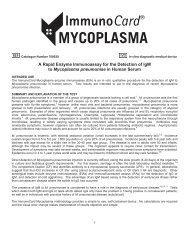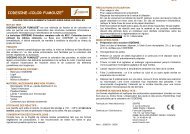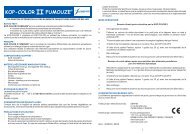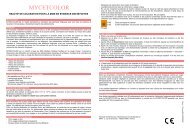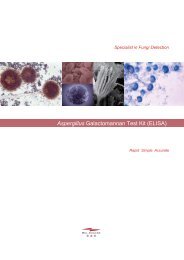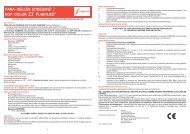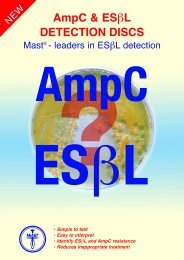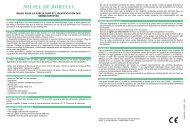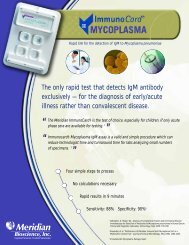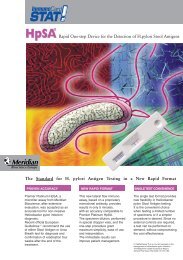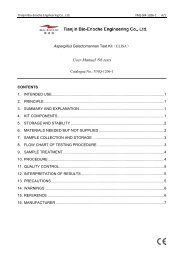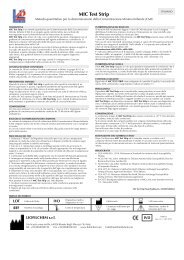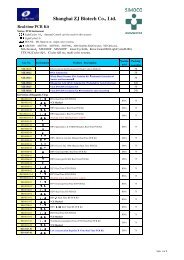MIC Test Strip
MIC Test Strip
MIC Test Strip
You also want an ePaper? Increase the reach of your titles
YUMPU automatically turns print PDFs into web optimized ePapers that Google loves.
<strong>MIC</strong> <strong>Test</strong> <strong>Strip</strong><br />
Metodo quantitativo per la determinazione della Concentrazione Minima Inibente (CMI)<br />
ITALIANO<br />
DESCRIZIONE<br />
<strong>MIC</strong> <strong>Test</strong> <strong>Strip</strong> è un metodo quantitativo per la determinazione della<br />
Concentrazione Minima Inibente (CMI) di un singolo agente antimicrobico nei<br />
confronti dei microrganismi e per la determinazione dei meccanismi di resistenza.<br />
<strong>MIC</strong> <strong>Test</strong> <strong>Strip</strong> sono strisce di carta, con caratteristiche peculiari, impregnate con<br />
un gradiente di concentrazioni predefinite dell!agente antibatterico, costituito da 15<br />
diluizioni comprese nell!intervallo delle diluizioni usato nei metodi convenzionali per<br />
la determinazione della CMI.<br />
Su un lato della striscia è riportata una scala di lettura graduata, espressa in<br />
"g/mL e una sigla che specifica il tipo di antimicrobico.<br />
<strong>MIC</strong> <strong>Test</strong> <strong>Strip</strong> sono previsti in una larga varietà di configurazioni. Ciascuna<br />
configurazione è disponibile nella variante da 30 e 100 test.<br />
CONTENUTO DELLE CONFEZIONI<br />
La variante da 30 test contiene 30 strip confezionati in blister, in gruppi di 10, in<br />
presenza di un essiccatore.<br />
La variante da 100 test contiene 100 strip confezionati in blister, in gruppi di 10, in<br />
presenza di un essiccatore.<br />
Ciascuna confezione contiene inoltre una provetta con essiccatore e un foglio<br />
istruzione.<br />
PRINCIPIO DEL METODO<br />
Quando la striscia di <strong>MIC</strong> <strong>Test</strong> <strong>Strip</strong> è applicata sulla superficie inoculata di un<br />
terreno agarizzato in piastra, il gradiente predefinito ed esponenziale dell'agente<br />
antimicrobico è rilasciato dalla striscia al terreno agarizzato.<br />
Dopo incubazione di 18 ore o più, si può osservare una zona di inibizione ellittica,<br />
simmetrica e centrata lungo la striscia.<br />
Il valore di CMI, espressa in "g/mL, viene letto nel punto di intersezione tra il bordo<br />
dell'ellisse di inibizione e la striscia <strong>MIC</strong> <strong>Test</strong> <strong>Strip</strong>.<br />
COMPOSIZIONE<br />
Gli strip sono preparati con carta di alta qualità, e ciascun strip è impregnato con<br />
un gradiente di concentrazioni predefinite costituito da 15 diluizioni dell!agente<br />
antibatterico.<br />
RACCOLTA E CONSERVAZIONE DEI CAMPIONI<br />
Le colonie da sottoporre al test di valutazione della Concentrazione Minima<br />
Inibente (CMI) vengono riprese dai terreni colturali seminati preventivamente con il<br />
campione in esame.<br />
In caso di colonie miste è necessario procedere alla purificazione dei ceppi<br />
batterici prima della semina .<br />
PROCEDURA DEL TEST<br />
1. Prelevare il “blister” dal frigorifero e lasciarlo per circa un!ora a temperatura<br />
ambiente in modo da evitare che all!apertura si depositi umidità di condensa sugli<br />
strip pregiudicandone la stabilità nel tempo.<br />
2. Toccare 4-5 colonie ben isolate e morfologicamente simili, da un terreno di<br />
coltura e sospenderle in 5 mL di un brodo colturale appropriato. Per microrganismi<br />
esigenti si raccomanda di sospendere le colonie in brodo ed utilizzare la<br />
sospensione entro 15 minuti.<br />
3. Confrontare la torbidità della sospensione con lo standard McFarland<br />
appropriato.<br />
4. Immergere un tampone sterile nella brodocoltura o in una sua diluizione<br />
opportuna e spremerlo sulla parete della provetta per eliminare l!eccesso di liquido.<br />
5. Strisciare sulla superficie del terreno, contenuto in piastra, in modo da produrre<br />
una crescita omogenea;prima di deporre le strisce lasciare che l'umidità in eccesso<br />
venga assorbita ed assicurarsi che la superficie dell'agar sia completamente<br />
asciutta.<br />
6. Depositare lo strip, assicurandosi che la scala graduata con i valori di CMI sia<br />
rivolta verso l'alto e il codice dell!antibiotico verso l!esterno della piastra; esercitare<br />
pressione con una pinzetta sterile sulla superficie dell!agar inoculata ed assicurarsi<br />
che la striscia sia a contatto con la superficie dell'agar per tutta la sua lunghezza.<br />
Non spostare le strisce di <strong>MIC</strong> <strong>Test</strong> <strong>Strip</strong> una volta deposte.<br />
7. Incubare la piastra in posizione rovesciata e nelle condizioni appropriate del<br />
microrgansimo in esame.<br />
8. Riporre gli strip non utilizzati all'interno della provetta contenuta nella<br />
confezione.<br />
INTERPRETAZIONE DEI RISULTATI<br />
Al termine dell'incubazione leggere i valori di CMI nel punto in cui il margine<br />
dell'ellisse di inibizione interseca la striscia (l!intersezione tra i due lati dello strip<br />
dovrebbe essere arrotondata al valore più alto).<br />
Per l'interpretazione delle CMI ottenute con <strong>MIC</strong> <strong>Test</strong> <strong>Strip</strong> possono essere<br />
utilizzati i valori di CMI adottati dalla CLSI.<br />
Nel caso di valori intermedi arrotondare sempre al valore di CMI superiore prima di<br />
stabilire una categoria di sensibilità. Nella tabella n°1 è riportato uno schema dei<br />
criteri di interpretazione della CLSI.<br />
INTERPRETAZIONE CLINICA<br />
Il test <strong>MIC</strong> <strong>Test</strong> <strong>Strip</strong> eseguito in vitro può riprodurre esattamente le condizioni che<br />
si trovano in vivo, ma può fornire solo una indicazione della potenziale sensibilità<br />
in vivo del microrganismo. La scelta finale della terapia da somministrare al<br />
paziente spetta al clinico che è in possesso di tutti i dati riguardanti il paziente<br />
stesso.<br />
CONTROLLO QUALITA!<br />
Ogni lotto di <strong>MIC</strong> TEST STRIP viene sottoposto al controllo di qualità, in accordo<br />
alle norme CLSI, utilizzando i ceppi batterici indicati in tabella n°1.<br />
PRECAUZIONI<br />
Il prodotto <strong>MIC</strong> <strong>Test</strong> <strong>Strip</strong> non è classificabile come pericoloso ai sensi della<br />
legislazione vigente, ma rientra nello specifico campo di applicazione della<br />
normativa relativa all!obbligo di fornitura di scheda di sicurezza, perché può<br />
causare fenomeni di sensibilizzazione in soggetti sensibili in caso di contatto con<br />
la pelle.<br />
<strong>MIC</strong> <strong>Test</strong> <strong>Strip</strong> è un dispositivo monouso. <strong>MIC</strong> <strong>Test</strong> <strong>Strip</strong> è solo per uso<br />
diagnostico in vitro, è destinato ad un ambito professionale e deve essere usato in<br />
laboratorio da operatori adeguatamente addestrati, con metodi approvati di asepsi<br />
e di sicurezza nei confronti degli agenti patogeni.<br />
CONSERVAZIONE<br />
La confezione integra di <strong>MIC</strong> <strong>Test</strong> <strong>Strip</strong> deve essere conservata a -20 - +8 °C fino<br />
alla data di scadenza indicata sulla confezione.<br />
Se le strisce estratte dai comparti sigillati non vengono immediatamente utilizzate,<br />
devono essere conservate a 2-8 °C nella provetta a chiusura ermetica, contenente<br />
essiccante, fornita nella confezione, sino alla data di scadenza.<br />
Non utilizzare oltre la data di scadenza.<br />
Eliminare se vi sono segni di deterioramento.<br />
ELIMINAZIONE DEL MATERIALE USATO<br />
Dopo l!utilizzazione <strong>MIC</strong> <strong>Test</strong> <strong>Strip</strong> ed il materiale venuto a contatto con il<br />
campione devono essere decontaminati e smaltiti in accordo con le tecniche in uso<br />
in laboratorio per la decontaminazione e lo smaltimento di materiale<br />
potenzialmente infetto.<br />
BIBLIOGRAFIA<br />
• Performance Standards for Antimicrobial Susceptibility <strong>Test</strong>ing.<br />
NCCLS M100-S Series , latest annual edition.<br />
• Methods for Dilution Antimicrobial Susceptibility <strong>Test</strong>s for Bacteria that Grow<br />
Aerobically. NCCLS M7-A6, 2003<br />
• Methods for Dilution Antimicrobial Susceptibility <strong>Test</strong>ing of Anaerobic Bacteria.<br />
NCCLS M11-A6, 2004.<br />
TABELLA DEI SIMBOLI<br />
LOT Codice del lotto IVD<br />
Dispositivo medico<br />
diagnostico in vitro<br />
Fabbricante<br />
REF Numero di catalogo Limiti di temperatura Contenuto sufficiente per<br />
saggi<br />
Utilizzare entro<br />
Attenzione, vedere le<br />
istruzioni per l!uso<br />
LIOFILCHEM s.r.l.<br />
Via Scozia zona ind.le, 64026 Roseto degli Abruzzi (Te) Italy<br />
Tel. +39 0858930745 Fax +39 0858930330 www.liofilchem.net liofilchem@liofilchem.net<br />
IVD<br />
F00023<br />
Rev.4 / 31.03.2009<br />
1
<strong>MIC</strong> <strong>Test</strong> <strong>Strip</strong><br />
Quantitative technique for determining the Minimum Inhibitory Concentration (<strong>MIC</strong>)<br />
ENGLISH<br />
DESCRIPTION<br />
<strong>MIC</strong> <strong>Test</strong> <strong>Strip</strong> is a quantitative technique for determining the Minimum Inhibitory<br />
Concentration (<strong>MIC</strong>) of antimicrobial agents against microorganisms and for<br />
detecting the resistance mechanisms.<br />
<strong>MIC</strong> <strong>Test</strong> <strong>Strip</strong> are paper strips with special features that are impregnated<br />
with a predefined concentration gradient of antibiotic, across 15 two-fold dilutions<br />
of a conventional <strong>MIC</strong> method.<br />
On one side of the strip is indicated a <strong>MIC</strong> scale in "g/mL and a code that identify<br />
the antimicrobial agent.<br />
<strong>MIC</strong> <strong>Test</strong> <strong>Strip</strong> are available in a large variety of configurations.<br />
Each configuration is available in packages of 30 and 100 tests.<br />
CONTENTS OF THE PACKAGES<br />
The 30-test version contains 30 strips packaged in “blister”, in group of ten, with a<br />
dryer.<br />
The 100-test version contains 100 strips packaged in “blister”, in group of ten, with<br />
a dryer.<br />
Each package contains also a tube with a dryer and an instruction sheet.<br />
METHOD PRINCIPLE<br />
When the <strong>MIC</strong> <strong>Test</strong> <strong>Strip</strong> is applied onto an inoculated agar surface, the<br />
preformed exponential gradient of antimicrobial agent is immediately transferred to<br />
the agar matrix.<br />
After 18 hours incubation or longer, a symmetrical inhibition ellipse centered along<br />
the strip is formed. The <strong>MIC</strong> is read directly from the scale in terms of "g/mL at the<br />
point where the edge of the inhibition ellipse intersects the strip <strong>MIC</strong> <strong>Test</strong> <strong>Strip</strong>.<br />
COMPOSITION<br />
The strips are made of high-quality paper and each strip is impregnated with a<br />
predefined concentration gradient across 15 two-fold dilutions of antibiotic agent.<br />
GATHERING AND KEEPING SAMPLES<br />
The colonies that are to be subjected to the evaluation of Minimum Inhibition<br />
Concentration (<strong>MIC</strong>) are taken up by culture media that have been previously<br />
swabbed with the sample under examination. In the case of mixed colonies the<br />
bacterial strains must be purified before inoculation.<br />
TEST PROCEDURE<br />
1. Take the “blister” of cartridges from the refrigerator and leave it for about an hour<br />
at ambient temperature in order to prevent condensation forming on the strips<br />
when it is opened as such condensation could affect long-term stability.<br />
2. Swab 4 to 5 well isolated and morphologically similar colonies with a culture<br />
medium and suspend them in 5 mL of a suitable suspension medium. Fastidious<br />
microorganisms should be suspended in broth and used within 15 minutes.<br />
3. Compare the turbidity to the appropriate McFarland standard.<br />
4. Dip a sterile swab in the broth culture or in a diluted form thereof and squeeze it<br />
on the wall of the test tube to eliminate excess liquid.<br />
5. Drag it along the surface of the medium contained on the plate so as to produce<br />
even growth; allow excess moisture to be absorbed and ensure that the surface is<br />
completely dry before applying strips.<br />
6. Apply the strip to the agar surface with the <strong>MIC</strong> scale facing upwards and code<br />
of the strip to the outside of the plate, pressing it with a sterile forceps on the<br />
surface of the agar and ensure that whole length of the antibiotic gradient is in<br />
complete contact with the agar surface. Once applied, do not move the strip.<br />
7. Incubate plates in an inverted position under conditions appropriate for the<br />
microorganism.<br />
8. Put the not used strips onto the tube contained in the package.<br />
EVALUATING THE RESULTS<br />
At the end of incubation read the <strong>MIC</strong> value where the edge of the inhibition ellipse<br />
intersects the strip (intersection between two scale segments should be round up<br />
to the higher value).<br />
<strong>MIC</strong> break points for defining susceptibility categories as provided by the CLSI<br />
could be used for interpreting <strong>MIC</strong> values.<br />
Always round up <strong>MIC</strong> <strong>Test</strong> <strong>Strip</strong> half dilution values to the next upper two-fold<br />
value before categorisation. An overview of CLSI interpretative criteria is provided<br />
in Table no.1.<br />
CLINICAL INTERPRETATION<br />
The test <strong>MIC</strong> <strong>Test</strong> <strong>Strip</strong> carried out in vitro cannot exactly reproduce in vivo<br />
conditions. Nevertheless, it shows the effect of the concentration of the antibiotic,<br />
which varies in the culture medium in relation to the growth of the microbial<br />
population.<br />
The final choice of antibiotic to administer to the patient is the responsibility of the<br />
clinician who possesses all the information on the patient.<br />
QUALITY CONTROL<br />
Each batch of <strong>MIC</strong> <strong>Test</strong> <strong>Strip</strong> is subjected to precise and thorough checks in<br />
compliance with CLSI standards using the bacterial strains indicated in the table<br />
no. 1.<br />
PRECAUTIONS<br />
The <strong>MIC</strong> <strong>Test</strong> <strong>Strip</strong> cannot be classified as being hazardous according to current<br />
legislation but fall within the specific field of application where a safety datasheet<br />
must be supplied because they can cause phenomena of sensitisation in sensitive<br />
subjects if they come into contact with the skin.<br />
<strong>MIC</strong> <strong>Test</strong> <strong>Strip</strong> are disposable products. <strong>MIC</strong> <strong>Test</strong> <strong>Strip</strong> are only for diagnostic in<br />
vitro use and are intended for professional use. They must be used in the<br />
laboratory by properly trained operators using approved aseptic and safety<br />
methods for pathogenic agents.<br />
STORAGE<br />
The unopened package of <strong>MIC</strong> <strong>Test</strong> <strong>Strip</strong> should be stored at -20 - +8 °C until the<br />
given expiry date.<br />
Leftover <strong>MIC</strong> <strong>Test</strong> <strong>Strip</strong> from an opened package must be stored at 2-8 °C in the<br />
airtight tube, containing desiccant, provided in the pack until the expiry date.<br />
Do not store them near sources of heat and do not expose them to excessive<br />
temperature variations.<br />
Do not use after this date.<br />
Dispose of if they show signs of deterioration.<br />
ELIMINATING USED MATERIAL<br />
After use, <strong>MIC</strong> <strong>Test</strong> <strong>Strip</strong> and the material that comes into contact with the sample<br />
must be decontaminated and disposed of in accordance with current laboratory<br />
techniques for the decontamination and disposal of potentially infected material.<br />
BIBLIOGRAPHY<br />
• Performance Standards for Antimicrobial Susceptibility <strong>Test</strong>ing.<br />
NCCLS M100-S Series , latest annual edition.<br />
• Methods for Dilution Antimicrobial Susceptibility <strong>Test</strong>s for Bacteria that Grow<br />
Aerobically. NCCLS M7-A6, 2003.<br />
• Methods for Dilution Antimicrobial Susceptibility <strong>Test</strong>ing of Anaerobic Bacteria.<br />
NCCLS M11-A6, 2004.<br />
TABLE OF SYMBOLS<br />
LOT Batch code IVD<br />
In Vitro Diagnostic<br />
Medical Device<br />
Manufacturer<br />
REF Catalogue number Temperature limitation Contains sufficient for <br />
tests<br />
Use by<br />
Caution,consult<br />
accompanying documents<br />
LIOFILCHEM s.r.l.<br />
Via Scozia zona ind.le, 64026 Roseto degli Abruzzi (Te) Italy<br />
Tel. +39 0858930745 Fax +39 0858930330 www.liofilchem.net liofilchem@liofilchem.net<br />
IVD<br />
F00023<br />
Rev.4 / 31.03.2009<br />
2
<strong>MIC</strong> <strong>Test</strong> <strong>Strip</strong><br />
Quantitative Methode zur Bestimmung der minimalen Hemm-Konzentration (MHK)<br />
DEUTSCH<br />
BESCHREIBUNG<br />
<strong>MIC</strong> <strong>Test</strong> <strong>Strip</strong> ist eine quantitative Bestimmung der minimalen Hemm-<br />
Konzentration (MHK) von antimikrobiellen Substanzen gegen Mikroorganismen<br />
und für die Bestimmung von Resistenz Mechanismen.<br />
<strong>MIC</strong> <strong>Test</strong> <strong>Strip</strong> sind spezielle Papier Streifen, imprägniert mit einem definierten<br />
Konzentrationsgradienten eines Antibiotikums über 15 zweifach<br />
Verdünnungsstufen einer konventionellen MHK Methode.<br />
Auf der Rückseite des Streifens ist eine entsprechende MHK Skala in "g/mL und<br />
ein Kode für die jeweilige antimikrobielle Substanz.<br />
<strong>MIC</strong> <strong>Test</strong> <strong>Strip</strong> gibt es in unterschiedlichen Konfigurationen und jede Konfiguration<br />
ist verfügbar in Packungen zu je 30 oder 100 <strong>Test</strong>s.<br />
INHALT DER PACKUNGEN<br />
Die 30-<strong>Test</strong> Version enthält 30 Streifen, verpackt in einer “Blister” Packung, mit<br />
jeweils 10 Streifen pro Einheit mit einem Trockenmittel.<br />
Die 100-<strong>Test</strong> Version enthält 100 Streifen, verpackt in einer “Blister” Packung, mit<br />
jeweils 10 Streifen pro Einheit mit einem Trockenmittel.<br />
Jede Packung enthält ausserdem ein Röhrchen mit Trockenmittel und eine<br />
Gebrauchsanleitung.<br />
TESTPRINZIP<br />
Legt man den <strong>MIC</strong> <strong>Test</strong> <strong>Strip</strong> auf eine inokulierte Agaroberfläche, wird der<br />
vorgeformte exponentielle Gradient der antimikrobiellen Substanz sofort auf die<br />
Agarmatrix übertragen.<br />
Nach 18 stündiger Inkubation oder länger, wird entlang des Streifens eine<br />
symmetrische Hemmungsellipse gebildet. Die MHK wird direkt von der Skala in<br />
"g/mL an dem Punkt abgelesen, wo die Hemmungsellipse den <strong>MIC</strong> <strong>Test</strong> <strong>Strip</strong><br />
schneidet.<br />
ZUSAMMENSETZUNG<br />
DIe Streifen sind aus Spezialpapier hoher Qualität gefertigt und jeder Streifen ist<br />
imprägniert mit einem vorgeformten Konzentrationsgradienten über 15 zweifach<br />
Verdünnungsstufen der antimikrobiellen Substanz.<br />
PROBEN<br />
Die auf die minimale Hemmkonzentration (MHK) zu überprüfenden Kolonieen<br />
werden von einem vorher mit der zu prüfenden Probe inokulierten Medium<br />
abgenommen. Bei Mischkulturen müssen vorher Reinkulturen hergestellt werden.<br />
TESTDURCHFÜHRUNG<br />
1. Den „Blister“ aus dem Kühl- oder Gefrierschrank nehmen und etwa 1 Stunde bei<br />
Raumtemperatur liegen lassen. Dies verhindert Kondensation von Wasser auf den<br />
Streifen, was zu einer Beeinträchtigung der Haltbarkeit führen könnte.<br />
2. 4 bis 5 isolierte und morphologisch ähnliche Kolonien mit einer Öse abnehmen<br />
und in 5 ml eines geeigneten Mediums suspendieren. Anspruchsvolle<br />
Mikroorganismen sollten in Flüssigmedium suspendiert und innerhalb von 15<br />
Minuten verwendet werden.<br />
3. Vergleiche die Trübung mit dem geeigneten McFarland Standart und stelle die<br />
Suspension entsprechend ein.<br />
4. Tauche einen sterilen Tupfer in die eingestellte Suspension, drücke den Tupfer<br />
gegen die Röhrchenwand um überschüssige Flüssigkeit zu entfernen.<br />
5. Mit dem Tupfer die Agarplatte so ausstreichen, dass ein gleichmässiges<br />
Wachstum erfolgt. Die Plattenoberfläche abtrocknen lassen und sicherstellen, dass<br />
die Oberfläche der Platten vor dem Auflegen der Streifen trocken ist.<br />
6. Den Streifen auf die Agaroberfläche auflegen mit der Skala nach oben und dem<br />
Kode für die Substanz nach aussen. Den Streifen mit der Pinzette andrücken und<br />
darauf achten, dass er auf der ganzen Länge aufliegt. Den Streifen nach Kontakt<br />
mit dem Agar nicht mehr verschieben!<br />
7. Platten umgedreht unter geeigneten Bedingungen für die jeweiligen Keime<br />
inkubieren.<br />
8. Die nicht benützten Streifen im mitgelieferten Röhrchen lagern.<br />
ABLESUNG DER ERGEBNISSE<br />
Am Ende der Inkubationszeit die MHK da ablesen, wo der Rand der Hemmellipse<br />
den Streifen schneidet.<br />
MHK Grenzkonzentrationen (Breakpoints) zur Definition der<br />
Empfindlichkeitskategorien wie die von CLSI können zur Interpretation der MHK<br />
Werte benützt werden.<br />
Der Streifen zeigt auch Zwischenwerte der Verdünnungsstufen. Bei der<br />
Kategorisierung (in S, I oder R) bei Zwischenwerten immer auf den nächsten<br />
vollen Verdünnungsschritt aufrunden. Eine Übersicht von CLSI Werten ist in<br />
Tabelle 1 dargestellt.<br />
KLINISCHE INTERPRETATION<br />
<strong>MIC</strong> <strong>Test</strong> <strong>Strip</strong> ist ein in vitro <strong>Test</strong> und er kann nicht in vivo Bedingungen exakt<br />
darstellen. Dennoch zeigt er den konzentrationsabhängigen Effekt des<br />
Antibiotikums. Dieser variiert im Kulturmedium in Abhängigkeit zum Wachstum der<br />
mikrobiellen Population.<br />
Die endgültige Entscheidung, welches Antibiotikum der Patient bekommt, liegt in<br />
der Verantwortlichkeit des Klinikers, der alle Informationen über den Patienten<br />
besitzt.<br />
QUALITÄTSKONTROLLE<br />
Jede Charge des <strong>MIC</strong> <strong>Test</strong> <strong>Strip</strong> wird präzisen und sorgfältigen Kontrollen gemäss<br />
der CLSI Standards mit den Stämmen durchgeführt, die in Tabelle 1 aufgeführt<br />
sind.<br />
VORSICHTSMASSNAHMEN<br />
Nach gegenwärtiger Gesetzgebung kann <strong>MIC</strong> <strong>Test</strong> <strong>Strip</strong> nicht als gefährlich<br />
eingestuft werden, er fällt aber in einen Anwendungsbereich, wo ein<br />
Sicherheitsdatenblatt zur Verfügung gestellt werden muss, da der <strong>Test</strong> eine<br />
Sensibilisierung bei empfindlichen Personen verursachen kann, wenn sie mit der<br />
Haut in Kontakt kommen.<br />
<strong>MIC</strong> <strong>Test</strong> <strong>Strip</strong> ist zum einmaligen Gebrauch bestimmt. <strong>MIC</strong> <strong>Test</strong> <strong>Strip</strong> ist nur für<br />
die diagnostische in vitro <strong>Test</strong>ung und professionellen Einsatz. Er muss im Labor<br />
von gut geschultem Personal angewendet werden unter Berücksichtigung der<br />
Regeln für das Arbeiten mit pathogenen Keimen.<br />
LAGERUNG<br />
<strong>MIC</strong> <strong>Test</strong> <strong>Strip</strong> muss für längere Perioden bei -20°C in der Originalverpackung<br />
gelagert werden. Für kure Perioden kann <strong>MIC</strong> <strong>Test</strong> <strong>Strip</strong> auch bei 2-8 °C gelagert<br />
werden, vorausgesetzt, er befindet sich noch in der Originalverpackung. Nicht in<br />
der Nähe von Hitzequellen lagern oder hohen Temperaturschwankungen<br />
aussetzen. Die Streifenpackungen müssen nach Gebrauch so schnell wie möglich<br />
wieder kalt gelagert werden. Unter solchen Bedingungen kann <strong>MIC</strong> <strong>Test</strong> <strong>Strip</strong> bis<br />
zum Verfallsdatum auf dem Etikett benützt werden. Nach diesem Datum oder bei<br />
Anzeichen einer Schädigung der Streifen den <strong>Test</strong> nicht mehr benützen.<br />
ENTSORGUNG VON GEBRAUCHTEM MATERIAL<br />
Nach Gebrauch wird <strong>MIC</strong> <strong>Test</strong> <strong>Strip</strong> zusammen mit den Agarplatten entsprechend<br />
den Laborrichtlinien für infektiöses Material entsorgt.<br />
BIBLIOGRAPHIE<br />
• Performance Standards for Antimicrobial Susceptibility <strong>Test</strong>ing.<br />
NCCLS M100-S Series , latest annual edition.<br />
• Methods for Dilution Antimicrobial Susceptibility <strong>Test</strong>s for Bacteria that Grow<br />
Aerobically. NCCLS M7-A6, 2003.<br />
• Methods for Dilution Antimicrobial Susceptibility <strong>Test</strong>ing of Anaerobic Bacteria.<br />
NCCLS M11-A6, 2004.<br />
SYMBOLE<br />
LOT Charge IVD für In Vitro Diagnostik Hersteller Siehe Verfallsdatum auf dem<br />
Etikett<br />
REF Artikelnummer Temperaturbereich Enthält Material für <br />
<strong>Test</strong>s, siehe Etikett<br />
Vorsicht, Begleitdokumente<br />
beachten<br />
LIOFILCHEM s.r.l.<br />
Via Scozia zona ind.le, 64026 Roseto degli Abruzzi (Te) Italy<br />
Tel. +39 0858930745 Fax +39 0858930330 www.liofilchem.net liofilchem@liofilchem.net<br />
IVD<br />
F00023<br />
Rev.4 / 31.03.2009<br />
3
<strong>MIC</strong> <strong>Test</strong> <strong>Strip</strong><br />
<strong>Test</strong> na kvantitatívne stanovenie minimálnej inhibi#nej koncentrácie (<strong>MIC</strong>)<br />
SLOVEN$INA<br />
POPIS<br />
<strong>MIC</strong> <strong>Test</strong> <strong>Strip</strong> je test na kvantitatívne stanovenie minimálnej inhibi#nej<br />
koncentrácie (<strong>MIC</strong>) antimikrobiálnych látok a na stanovenie mechanizmov<br />
rezistencie mikroorganizmov.<br />
<strong>MIC</strong> <strong>Test</strong> <strong>Strip</strong> je papierov% prú&ok 'peciálnych vlastností, ktor% je impregnovan%<br />
preddefinovan%m koncentra#n%m gradientom antibiotika – 15 dvojnásobn%ch<br />
riedení konven#nej <strong>MIC</strong> metódy.<br />
Na lícnej strane je 'kála koncentrácie <strong>MIC</strong> v "g/ml a kódové ozna#enie<br />
antimikrobiálnej látky.<br />
<strong>MIC</strong> <strong>Test</strong> <strong>Strip</strong> je dostupn% v 'irokej ponuke antimikrobiálnych látok v baleniach po<br />
30 a 100 prú&kov.<br />
OBSAH BALENIA<br />
30-testové balenie obsahuje 30 prú&kov zabalen%ch blistrov%m spôsobom po 10<br />
prú&kov spolu s desikátorom.<br />
100-testové balenie obsahuje 100 prú&kov zabalen%ch blistrov%m spôsobom po 10<br />
prú&kov spolu s desikátorom.<br />
Ka&dé balenie obsahuje skúmavku s desikátorom a návod na pou&itie.<br />
PRINCÍP<br />
Po polo&ení <strong>MIC</strong> <strong>Test</strong> <strong>Strip</strong> prú&ku na inokulovan% povrch platne je do pôdy ihne(<br />
uvo)nen% preddefinovan% exponenciálny gradient antimikrobiálnej látky.<br />
Po 18 hodinách inkubácie vznikne symetrická eliptická zóna inhibície v centre s<br />
prú&kom. Hodnotu <strong>MIC</strong> je mo&né od#íta* priamo v jednotkách "g/ml z prú&ku v<br />
mieste, kde inhibi#ná elipsa pretína <strong>MIC</strong> <strong>Test</strong> <strong>Strip</strong> prú&ok.<br />
ZLO"ENIE<br />
Prú&ok je vyroben% zo 'peciálneho papiera a je impregnovan% preddefinovan%m<br />
koncentra#n%m gradientom antibiotika – 15 dvojnásobn%ch riedení.<br />
OBER A SKLADOVANIE VZORIEK<br />
Kolónie baktérií, ktoré majú by* testované na stanovenie <strong>MIC</strong> majú by* odobraté z<br />
kultiva#ného média, na ktorom prebiehalo vy'etrenie vzorky. V prípade zmie'anej<br />
kultúry je potrebné pred testovaním <strong>MIC</strong> najskôr vzorky “vy#isti*”<br />
POSTUP PRÁCE<br />
1. Vyberte balenie prú&kov z chladni#ky a nechajte ho uzavreté asi 1 hodinu<br />
vytemperova* na laboratórnu teplotu, tak aby po otvorení balenia nekondenzovala<br />
vodná para na prú&koch. Vlhkos* mô&e vpl%va* na stabilitu testu pri skladovaní.<br />
2. Odoberte 4-5 dobre izolovan%ch kolónií podobnej morfológie a rozrie(te ich v 5<br />
ml riediacom médiu. Rastovo náro#né baktérie musia by* rozriedené kultiva#n%m<br />
bujónom a+ponechané v+,om po dobu 15 minút.<br />
3. Presved#te sa, &e ste získali správnu hodnotu turbidity.<br />
4. Ponorte steriln% tampón do skúmavky so vzorkou a o steny skúmavky vytla#te<br />
nadbyto#nú tekutinu z tampóna.<br />
5. Dôkladne natrite povrch kultiva#ného média, tak aby ste dosiahli rovnomern%<br />
rast. Pred polo&ením prú&ka musí by* povrch platne úplne such%!<br />
6. Polo&te prú&ok na plat,u <strong>MIC</strong> 'kálou nahor a jemne prú&ok pritla#te, tak aby sa<br />
cel% povrch prú&ka dot%kal povrchu platne. S polo&en%m prú&kom na platni viac<br />
nepohybujte!<br />
7. Inkubujte platne v prevrátenej pozícii za podmienok vhodn%ch pre konkrétne<br />
testované mikroorganizmy.<br />
8. Nepou&ité prú&ky odlo&te do chladni#ky v prilo&enej skúmavke s desikátorom.<br />
VYHODNOTENIE V#SLEDKOV<br />
Po ukon#ení inkubácie od#ítajte hodnotu <strong>MIC</strong> v mieste, kde sa inhibi#ná elipsa<br />
dot%ka prú&ku. V+prípade nerovnak%ch v%sledkov oboch #astí inhibi#nej elipsy,<br />
pou&ite vy''iu získanú hodnotu <strong>MIC</strong>.<br />
Na interpretovanie získan%ch <strong>MIC</strong> hodnôt mô&u by* pou&ité hodnoty break pointov,<br />
ktoré sú poskytované CLSI.<br />
V%sledky, ktoré sa nachádzajú medzi dvoma hodnotami dvojnásobn%ch riedení,<br />
zaokrúhlite pred interpretáciou nahor.<br />
Preh)ad CLSI interpreta#n%ch kritérií je v tabu)ke #.1.<br />
KLINICKÁ INTERPRETÁCIA<br />
<strong>MIC</strong> <strong>Test</strong> <strong>Strip</strong> test vykonan% in vitro nemô&e v&dy presne zodpoveda* in vivo<br />
podmienkam. Napriek tomu ukazuje efekt rôznej koncentrácie antibiotika v<br />
kultiva#nom médiu na rast mikroorganizmov.<br />
Kone#né rozhodnutie pri v%bere antibiotika je v zodpovednosti o'etrujúceho<br />
lekára, po zhodnotení v'etk%ch informácii o pacientovi.<br />
KONTROLA KVALITY<br />
Ka&dá 'ar&a <strong>MIC</strong> <strong>Test</strong> <strong>Strip</strong> je dôkladne a starostlivo testovaná, #i vyhovuje CLSI<br />
'tandardom. Na kontrolu sú pou&ité bakteriálne kmene uvedené v tabu)ke #.1.<br />
BEZPE$NOSTNÉ OPATRENIA<br />
<strong>MIC</strong> <strong>Test</strong> <strong>Strip</strong> v zmysle sú#asnej legislatívy nie sú klasifikované ako nebezpe#né,<br />
ale v prípade niektor%ch aplikácií mô&u senzibilizova* citlivé osoby ak test príde do<br />
kontaktu s poko&kou.<br />
<strong>MIC</strong> <strong>Test</strong> <strong>Strip</strong> sú jednorázové testy. <strong>MIC</strong> <strong>Test</strong> <strong>Strip</strong> sú ur#ené len na diagnostiku<br />
in vitro a na profesionálne pou&itie. <strong>Test</strong>y mô&u by* pou&ité iba v laboratóriu<br />
za'kolen%m personálom za pou&itia aseptick%ch a bezpe#n%ch postupov pri práci<br />
s patogénnymi mikroorganizmami.<br />
SKLADOVANIE<br />
<strong>MIC</strong> <strong>Test</strong> <strong>Strip</strong> neotvorené balenie mô&e by* skladované pri teplote -20 - 8 °C. Po<br />
otvorení originálneho balenia, prú&ky, ktoré zostali musia by* skladované v<br />
dodávanej vzduchotesnej skúmavke s desikátorom pri teplote 2 - 8 °C. Neskladujte<br />
ich pri zdroji tepla a nevystavujte ich kolísav%m zmenám teploty.<br />
Nepou&ívajte ich po uplynutí exspira#nej doby. <strong>Test</strong>y zlikvidujte ak majú známky<br />
po'kodenia.<br />
LIKVIDÁCIA ODPADU<br />
<strong>MIC</strong> <strong>Test</strong> <strong>Strip</strong> prú&ky a v'etok materiál, ktor% pri'iel do styku so vzorkou<br />
zlikvidujte ako potencionálne infek#n% materiál.<br />
LITERATÚRA<br />
• Performance Standards for Antimicrobial Susceptibility <strong>Test</strong>ing.<br />
NCCLS M100-S Series , latest annual edition.<br />
• Methods for Dilution Antimicrobial Susceptibility <strong>Test</strong>s for Bacteria that Grow<br />
Aerobically. NCCLS M7-A6, 2003.<br />
• Methods for Dilution Antimicrobial Susceptibility <strong>Test</strong>ing of Anaerobic Bacteria.<br />
NCCLS M11-A6, 2004.<br />
TABU%KA SYMBOLOV<br />
LOT $íslo 'ar&e IVD<br />
Len na diagnostiku In<br />
Vitro<br />
V%robca<br />
REF Katalógové #íslo Teplota skladovania Balenie obsahuje <br />
testov<br />
Pou&ite do<br />
Upozornenie, pre'tudujte<br />
prilo&ené informácie<br />
LIOFILCHEM s.r.l.<br />
Via Scozia zona ind.le, 64026 Roseto degli Abruzzi (Te) Italy<br />
Tel. +39 0858930745 Fax +39 0858930330 www.liofilchem.net liofilchem@liofilchem.net<br />
IVD<br />
F00023<br />
Rev.4 / 31.03.2009<br />
4
<strong>MIC</strong> <strong>Test</strong> <strong>Strip</strong><br />
-./0123 456571258 4956:15916"58 7;< .=>/167;< ?0?67?=7123< 6@A2B079C6;< (<strong>MIC</strong>)<br />
D==;012><br />
&'()*(+,-<br />
-5 <strong>MIC</strong> <strong>Test</strong> <strong>Strip</strong> .E0?1 B0?< 4565712F< 4956:15916"F< 7;< .=>/167;<<br />
?0?67?=7123< 6@A2B079C6;< (<strong>MIC</strong>) ?071"1295G1?2H0 4?9?AF07C0 B0?071<br />
"129559A?016"H0 A1? 7;0 ?0E/0.@6; ";/?016"H0 ?0I.2712F7;7?9710.< 7?10E.< ". 1:1?E7.9? /?9?27;916712> 7? 545E?<br />
.E0?1 ."45716"B0? ". 4952?I5916"B0; 2?1 :1?G?I"16"B0; 6@A2B079C6;<br />
?071G15712H0 2?7> "325< 15 47@/H0 75@ strip ". ?07E6751/.< ?9?1H6.1< ?4F<br />
"1? 6@"G?7123 <strong>MIC</strong> "BI5:5.<br />
J7; "1? 4=.@9> 75@ strip ?0?A9>K.7?1 ; <strong>MIC</strong> 2=E"?2? 6. "g/ml 2?1 5 2C:12F<<br />
?0?A0H916;< 75@ ?071"1295G1?258 4?9>A507?.<br />
-5 LMC <strong>Test</strong> <strong>Strip</strong> .E0?1 :1?IB61"? 6. ".A>=; 45121=E? 6@0IB6.C0.N>I.<br />
680I.6; .E0?1 :1?IB61"; 6. 4?2B7? 7C0 30 2?1 100 test.<br />
&'()'./0'1+<br />
O B2:56; 7C0 30 test 4.91B/.1 30 strips 6. :1>K?0; 6@62.@?6E? ?0> 10 ".<br />
P;9?0712F "B65.<br />
O B2:56; 7C0 100 test 4.91B/.1 100 strips 6. :1>K?0; 6@62.@?6E? ?0> 10 ".<br />
P;9?0712F "B65.N>I. 4?2B75 4.91=?"G>0.1 B0? 6C=;0>915 ". P;9?0712F<br />
"B65 2?1 75 K@==>:15 5:;A1H0.<br />
+(.- 2-3 0'4/5/6<br />
Q7?0 75 <strong>MIC</strong> <strong>Test</strong> <strong>Strip</strong> .K?9"FR.7?1 67;0 .41K>0.1? .0F< ."G5=1?6"B05@<br />
agar ; 4952?I5916"B0; .2I.7123 :1?G>I"16; 75@ ?071"1295G1?258<br />
4?9>A507? ".7?KB9.7?1 >".6? 675 6H"? 75@ agar.<br />
L.7> ?4F 18 3 4?9?4>0C H9.< .4H?6;".6? ?0?A0H61"; ?4F 7; :1?G>I"16; 6. "g/dl 675 6;".E5 F45@ ;<br />
G>6; 7;< ?0?67?=7123< B==.1S;< 7B"0.1 75 <strong>MIC</strong> <strong>Test</strong> <strong>Strip</strong>.<br />
3614'3-<br />
-? strips .E0?1 2?7?62.@?6"B0? ?4F /?97E @S;=3< 451F7;7?< 2?1 2>I. strip<br />
.E0?1 ."45716"B05 ". 4952?I5916"B0.< :1?G?I"E6.1< 6@A2.079H6.C0 15<br />
47@/H0 ". ?9?1C"B05@< 6@07.=.67B< ?071G15712H0.<br />
3677/*- 8+) 5)+2-(-3- 5')*0+291<br />
T1 ?4512E.< 51 545E.< I? @45G=;I580 6. ?P15=FA;6; .=>/167;<<br />
?0?67?=7123< 6@A2B079C6;< B/5@0 6@==./I.E ?4F I9.4712> @=12> 67?<br />
545E? B/5@". .0?45IB6.1 75 495< .PB7?6; :.EA"?.J7;0 4.9E47C6; 4512E=C0<br />
?45121H0 75 "1295G1?2F 67B=./5< 49B4.1 0? 2?I?9167.E 4910 750 ."G5=1?6"F.<br />
5)+5)8+3)+ 2'32<br />
1.UA>=7. 7; :1?K>0.1? ". 7? strips .27F< S@A.E5@ 2?1 ?K367. 7;0 4.9E45@<br />
"E? H9? 6. I.9"529?6E? 4.91G>==5075< B761 H67. 0? ?4579?4.E ;<br />
@A9545E;6; 45@ 6/;"?7ER.7?1 67? :162E? F7?0 ?05EA507?1 , ; 545E? "459.E 0?<br />
.4;9.>6.1 7; 67?I.9F7;7? 75@< 67; :1>92.1? 75@ /9F05@.<br />
2.N>07. =3S; 4 3 5 ?45"50C"B0C0 2?1 "59K5=5A12> 4?9F"51C0 ?45121H0<br />
2?1 .0?45IB67. 6. 5 ml 2?7>==;=5@ .0?1C93"?75==;=; Lc Farland 2=E"?2?.<br />
4.U@IE67. B0? ?4567.19C"B05 67@=.F 675 "B65 ".7?K59>< 2?==1.9A.1H0 3<br />
6. B0? ?9?1C"B05 :1>=@"? 75@ 2?1 679?AAE67. 75 67? 751/H"?7? 75@<br />
6C=;0?9E5@ A1? 0? .P?=.ES.7. 7;0 4.9E66.1? @A958.<br />
5. T:;A.E67. 75 2?7> "325< 7;< .41K>0.1?< 75@ I9.471258 @=1258 ". 7B7515<br />
79F45 6?0 0? B/.1 4?9?/I.E 6!?@7F.VK367. 7;0 4.9E66.1? @A9?6E?< 0?<br />
?45995K;I.E 2?1 G.G?1CI.E7. F71 ; .41K>0.1? .E0?1 ?45=87C< 67.A03 4910<br />
?4=H6.7. 7? strip.<br />
6.V4=H67. 75 strip 67;0 .41K>0.1? 75@ agar ". 7;0 2=E"?2? <strong>MIC</strong> 495< 7?<br />
.4>0C 2?1 41B67. 75 ". "1? ?4567.19C"B0; 761"4E:? 67;0 .41K>0.1? 75@ agar<br />
2?1 G.G?1CI.E7. F71 5=F2=;95 75 "325< 7;< :1?G>I"16;< 7C0 ?071G15712H0<br />
.E0?1 6. ?4F=@7; .4?K3 ". 7;0 .41K>0.1? 75@ agar. A4F 7; 671A"3 45@ B/.7.<br />
?4=H6.1 75 strip "; 75 ".7?210.E7..<br />
7.D4C>67. 7? 79@G=E? 6. ?0.679?""B0; IB6; 6. 6@0I32.< 2?7>==;=.< A1?<br />
75@< "129559A?016"58=7. 7? "; /9;61"5451;"B0? strip 675 6C=;0>915 45@ 4.91B/.7?1 675<br />
25@7E.<br />
'(0-1')+ +&/2'7'30+291<br />
J75 7B=5< 7;< .4H?6;< :1?G>67. 7;0 71"3 <strong>MIC</strong> .2.E 45@ ; >29; 7;<<br />
?0?67?=7123< B==.1S;< 7B"0.1 75 strip.-? 6;".E? :1?2543< 3 ?0?675=3<<br />
=.175@9AE?< 7;< .=>/167;< ?0?67?=7123< 6@A2B079C6;< A1? 750<br />
4956:15916"F 7C0 2?7;A591H0 .@?16I;6E?< F4C< 495G=B4507?1 ?4F 7;0<br />
CLSI "459580 0? /9;61"5451;I580 A1? 7;0 .9";0.E? 7C0 71"H0 <strong>MIC</strong>.<br />
J795AA@=5451367. 4>07? 7;0 71"3 ?4F 75 <strong>MIC</strong> <strong>Test</strong> <strong>Strip</strong> 67;0 ?"B6C<<br />
.4F".0; @S;=F7.9; 71"3 4910 7;0 2?7;A591545E;6;.L1? .4162F4;6;<br />
.9";0.@712H0 2917;9EC0 ?4F 7;0 CLSI 4?9B/.7?1 6750 4E0?2? 1.<br />
87)1)8- '(0-1')+<br />
O :521"?6E? <strong>MIC</strong> <strong>Test</strong> <strong>Strip</strong> 45@ .K?9"FR.7?1 in vitro :. "459.E 0? ?0?4?9>A.1<br />
6@0I32.< in vivo. W?9F=? ?@7> :.E/0.1 7;0 .4E:9?6; 7;< 6@A2B079C6;< 75@<br />
?071G1571258 , ; 545E? 4512E==.1 ?0>=5A? ". 75 I9.4712F @=12F 2?1 6.<br />
6@0>97;6; ". 7;0 ?0>47@P; "1295G1?258 4=;I@6"58.O 7.=123 .41=5A3 75@<br />
?071G1571258 45@ 4?9B/.7?1 6750 ?6I.03 .E0?1 67;0 .@I80; 75@ 2=101258<br />
A1?7958 45@ 2?7B/.1 F=.< 71< 4=;95K59E.< A1? 750 ?6I.03.<br />
&/)/2)8/3 '7'*./3<br />
N>I. 4?97E:? <strong>MIC</strong> <strong>Test</strong> <strong>Strip</strong> @45G>==.7?1 6. 6/5=?671258< 2?1 :1.P5:1258<<br />
.=BA/5@< 6. 6@""F9KC6; ". 7? 49F7@4? CLSI /9;61"5451H07?< 7?<br />
G?27;91:1?2> 67.=B/; 45@ ."K?0ER507?1 6750 4E0?2? 1.<br />
&(/,67+:')3<br />
-5 <strong>MIC</strong> <strong>Test</strong> <strong>Strip</strong> :. "459.E 0? 7?P105";I.E C< .412E0:@05 68"KC0? ". 7;0<br />
16/85@6? 05"5I.6E? ?==> @4>A.7?1 675 .1:12F 4.:E5 .K?9"5A3< F45@ 75<br />
B07@45 ?6K>=.1?< 49B4.1 0? 4?9B/.7?1 A1?7E "459.E 0? 4952?=B6.1<br />
K?10F".0? :.9"?75=5A12> .@?E6I;7? F7?0 B9I.1 6. .4?K3 ". 75 :B9"?.<br />
-5 <strong>MIC</strong> <strong>Test</strong> <strong>Strip</strong> .E0?1 495XF0 "1?< /936;:1? ?==5EC6;
ANTIBIOTIC CODE <strong>MIC</strong> =g/mL REF REF<br />
AMIKACIN AK 0.016 - 256 92018 30 920180 100<br />
AMOXICILLIN AML 0.016 - 256 92021 30 920210 100<br />
AMOXICILLIN* / CLAVULANIC ACID (2/1) AUG 0.016 - 256* 92024 30 920240 100<br />
AMPICILLIN AMP 0.016 - 256 92003 30 920030 100<br />
AMPICILLIN*/ SULBACTAM (2/1) AMS 0.016 - 256* 92027 30 920270 100<br />
AZITHROMYCIN AZM 0.016 - 256 92030 30 920300 100<br />
AZTREONAM ATM 0.016 - 256 92033 30 920330 100<br />
CEFACLOR CEC 0.016 - 256 92036 30 920360 100<br />
CEFEPIME FEP 0.016 - 256 92126 30 921260 100<br />
CEFIXIME CFM 0.016 - 256 92060 30 920600 100<br />
CEFOTAXIME CTX 0.016 - 256 92006 30 920060 100<br />
CEFOXITIN FOX 0.016 - 256 92066 30 920660 100<br />
CEFTAZIDIME CAZ 0.016 - 256 92138 30 921380 100<br />
CEFTRIAXONE CRO 0.016 - 256 92042 30 920420 100<br />
CEPHALOTHIN KF 0.016 - 256 92039 30 920390 100<br />
CHLORAMPHENICOL C 0.016 - 256 92075 30 920750 100<br />
CIPROFLOXACIN CIP 0.002 - 32 92045 30 920450 100<br />
CLARITHROMYCIN CLR 0.016 - 256 92048 30 920480 100<br />
CLINDAMYCIN CD 0.016 - 256 92072 30 920720 100<br />
ERYTHROMYCIN E 0.016 - 256 92051 30 920510 100<br />
FOSFOMYCIN FOS 0.016 - 256 92078 30 920780 100<br />
GENTA<strong>MIC</strong>IN CN 0.016 - 256 92009 30 920090 100<br />
IMIPENEM IMI 0.002 - 32 92054 30 920540 100<br />
LEVOFLOXACIN LEV 0.002 - 32 92081 30 920810 100<br />
LINEZOLID LNZ 0.016 - 256 92135 30 921350 100<br />
MEROPENEM MRP 0.002 - 32 92084 30 920840 100<br />
METRONIDAZOLE LZ 0.016 - 256 92087 30 920870 100<br />
MOXIFLOXACIN MXF 0.002 - 32 92090 30 920900 100<br />
NALIDIXIC ACID NA 0.016 - 256 92132 30 921320 100<br />
NETIL<strong>MIC</strong>IN NET 0.016 - 256 92093 30 920930 100<br />
NORFLOXACIN NOR 0.016 - 256 92096 30 920960 100<br />
OFLOXACIN OFX 0.002 - 32 92099 30 920990 100<br />
OXACILLIN OX 0.016 - 256 92015 30 920150 100<br />
PENICILLIN G P 0.002 - 32 92103 30 921030 100<br />
PENICILLIN G P 0.016 - 256 92102 30 921020 100<br />
PIPERACILLIN PIP 0.016 - 256 92105 30 921050 100<br />
PIPERACILLIN* / TAZOBACTAM (4 "g/mL) TZP 0.016 - 256* 92108 30 921080 100<br />
RIFAMPICIN RD 0.002 - 32 92001 30 920010 100<br />
STREPTOMYCIN S 0.064 - 1024 92111 30 921110 100<br />
TEICOPLANIN TEC 0.016 - 256 92012 30 920120 100<br />
TETRACYCLINE TE 0.016 - 256 92114 30 921140 100<br />
TICARCILLIN* / CLAVULANIC ACID (2 "g/mL) TTC 0.016 - 256* 92117 30 921170 100<br />
TOBRAMYCIN TOB 0.064 - 1024 92120 30 921200 100<br />
TRIMETHOPRIM* / SULFAMETHOXAZOLE (1/19) SXT 0.002 - 32* 92123 30 921230 100<br />
VANCOMYCIN VA 0.016 - 256 92057 30 920570 100<br />
More molecules will be soon available.<br />
6
Table no.1<br />
INTERPRETATIVE CRITERIA AND QUALITY CONTROL<br />
ANTIBIOTIC CODE INTERPRETATIVE CRITERIA <strong>MIC</strong> !g/mL S! I R" QUALITY CONTROL <strong>MIC</strong> #g/mL<br />
AMIKACIN<br />
0,016 - 256 !g/mL AK<br />
AMOXICILLIN<br />
0,016 - 256 !g/mL<br />
AMOXICILLIN* /<br />
CLAVULANIC ACID (2/1)<br />
0,016 - 256 * !g/mL AUG<br />
AMPICILLIN<br />
0,016 - 256 !g/mL<br />
AMPICILLIN*/<br />
SULBACTAM (2/1)<br />
0,016 - 256 * !g/mL<br />
AZITHROMYCIN<br />
0,016 - 256 !g/mL<br />
AZTREONAM<br />
0,016 - 256 !g/mL<br />
CEFACLOR<br />
0,016 - 256 !g/mL<br />
CEFEPIME<br />
0,016 - 256 !g/mL<br />
CEFIXIME<br />
0,016 - 256 !g/mL<br />
CEFOTAXIME<br />
0,016 - 256 !g/mL<br />
Aerobes 16 32 64 S.aureus<br />
E.coli<br />
P.aeruginosa<br />
ATCC 29213<br />
ATCC 25922<br />
ATCC 27853<br />
AML S.pneumoniae Nonmeningitis 2 4 8 S.pneumoniae ATCC 49619 0,032-0,125<br />
AMP<br />
AMS<br />
AZM<br />
ATM<br />
CEC<br />
FEP<br />
CFM<br />
CTX<br />
CEFOXITIN<br />
0,016 - 256 !g/mL FOX<br />
CEFTAZIDIME<br />
0,016 - 256 !g/mL CAZ<br />
CEFTRIAXONE<br />
0,016 - 256 !g/mL<br />
CRO<br />
Enterobacteriaceae<br />
Staphylococci<br />
Haemophilus spp.<br />
S.pneumoniae Nonmeningitis<br />
Anaerobes<br />
Enterobacteriaceae<br />
Staphylococci<br />
Enterococci<br />
Haemophilus spp.<br />
Aerobes<br />
Haemophilus spp.<br />
Anaerobes<br />
Staphylococci<br />
H.influenzae (-CO 2)<br />
H.influenzae (+ CO 2)<br />
S.pneumoniae (-CO 2)<br />
S.pneumoniae (+CO 2)<br />
8<br />
4<br />
4<br />
2<br />
4<br />
8<br />
0,25<br />
8<br />
1<br />
8<br />
2<br />
8<br />
2<br />
4<br />
8<br />
0,5<br />
4<br />
16<br />
-<br />
-<br />
4<br />
8<br />
16<br />
-<br />
-<br />
2<br />
16<br />
-<br />
16<br />
4<br />
-<br />
-<br />
1<br />
8<br />
32<br />
8<br />
8<br />
8<br />
16<br />
32<br />
0,5<br />
16<br />
4<br />
32<br />
4<br />
32<br />
8<br />
-<br />
-<br />
2<br />
16<br />
E.coli<br />
E.coli<br />
H.influenzae<br />
S.pneumoniae<br />
B.fragilis<br />
S.aureus<br />
E.faecalis<br />
E.coli<br />
H.influenzae<br />
E.coli<br />
E.coli<br />
H.influenzae<br />
B.fragilis<br />
S.aureus<br />
H.influenzae (-CO 2)<br />
H.influenzae (+ CO 2)<br />
S.pneumoniae (-CO 2)<br />
S.pneumoniae (+CO 2)<br />
Gram - aerobes 8 16 32 E.coli<br />
P.aeruginosa<br />
Staphylococci<br />
Haemophilus spp.<br />
Aerobes<br />
Haemophilus spp.<br />
S.pneumoniae Nonmeningitis<br />
S.pneumoniae Meningitis<br />
8<br />
8<br />
8<br />
2<br />
1<br />
0,5<br />
16<br />
16<br />
16<br />
-<br />
2<br />
1<br />
32<br />
32<br />
32<br />
-<br />
4<br />
2<br />
E.coli<br />
H.influenzae<br />
E.coli<br />
P.aeruginosa<br />
H.influenzae<br />
S.pneumoniae<br />
Enterobacteriaceae 1 2 4 S.aureus<br />
E.coli<br />
Aerobes<br />
Haemophilus spp.<br />
N.gonorrhoeae<br />
S.pneumoniae Nonmeningitis<br />
S.pneumoniae Meningitis<br />
Streptococci (")<br />
Streptococci viridans<br />
Anaerobes<br />
Aerobes<br />
Staphylococci<br />
Anaerobes<br />
Aerobes<br />
Haemophilus spp.<br />
Aerobes<br />
Haemophilus spp.<br />
N.gonorrhoeae<br />
S.pneumoniae Nonmeningitis<br />
S.pneumoniae Meningitis<br />
Streptococci (")<br />
Streptococci viridans<br />
Anaerobes<br />
8<br />
2<br />
0,5<br />
1<br />
0,5<br />
0,5<br />
1<br />
16<br />
8<br />
4<br />
16<br />
8<br />
2<br />
8<br />
2<br />
0,25<br />
1<br />
0,5<br />
0,5<br />
1<br />
16<br />
16-32<br />
-<br />
-<br />
2<br />
1<br />
-<br />
2<br />
32<br />
16<br />
-<br />
32<br />
16<br />
-<br />
16-32<br />
-<br />
-<br />
2<br />
1<br />
-<br />
2<br />
32<br />
64<br />
-<br />
-<br />
4<br />
2<br />
-<br />
4<br />
64<br />
32<br />
8<br />
64<br />
32<br />
-<br />
64<br />
-<br />
-<br />
4<br />
2<br />
-<br />
4<br />
64<br />
S.aureus<br />
E.coli<br />
P.aeruginosa<br />
H.influenzae<br />
N.gonorrhoeae<br />
S.pneumoniae<br />
B.fragilis<br />
E.coli<br />
B.fragilis<br />
E.coli<br />
P.aeruginosa<br />
H.influenzae<br />
E.coli<br />
H.influenzae<br />
N.gonorrhoeae<br />
S.pneumoniae<br />
B.fragilis<br />
ATCC 25922<br />
ATCC 35218<br />
ATCC 49247<br />
ATCC 49619<br />
ATCC 25285<br />
ATCC 29213<br />
ATCC 29212<br />
ATCC 25922<br />
ATCC 49247<br />
ATCC 25922<br />
ATCC 35218<br />
ATCC 49247<br />
ATCC 25285<br />
ATCC 29213<br />
ATCC 49247<br />
ATCC 49247<br />
ATCC 49619<br />
ATCC 49619<br />
ATCC 25922<br />
ATCC 27853<br />
ATCC 25922<br />
ATCC 49766<br />
ATCC 25922<br />
ATCC 27853<br />
ATCC 49247<br />
ATCC 49619<br />
ATCC 29213<br />
ATCC 25922<br />
ATCC 29213<br />
ATCC 25922<br />
ATCC 27853<br />
ATCC 49247<br />
ATCC 49226<br />
ATCC 49619<br />
ATCC 25285<br />
ATCC 25922<br />
ATCC 25285<br />
ATCC 25922<br />
ATCC 27853<br />
ATCC 49247<br />
ATCC 25922<br />
ATCC 49247<br />
ATCC 49226<br />
ATCC 49619<br />
ATCC 25285<br />
1-4<br />
0,5-4<br />
1-4<br />
2-8<br />
4-16<br />
2-16<br />
0,032-0,125<br />
0,125-0,5<br />
0,25-1<br />
0,5-2<br />
2-8<br />
2-8<br />
2-8<br />
4-16<br />
2-8<br />
0,5-2<br />
0,5-2<br />
1-4<br />
4-16<br />
0,064-0,25<br />
0,5-2<br />
0,064-0,25<br />
1-4<br />
1-4<br />
1-4<br />
0,016-0,125<br />
1-4<br />
0,5-2<br />
0,064-0,25<br />
8-32<br />
0,25-1<br />
1-4<br />
0,032-0,125<br />
4-16<br />
0,125-0,5<br />
0,016-0,064<br />
0,032-0,125<br />
8-32<br />
1-4<br />
4-16<br />
0,064-0,5<br />
0,5-2<br />
0,125-1<br />
0,032-0,125<br />
0,064-0,25<br />
0,004-0,016<br />
0,032-0,125<br />
32-128<br />
CEPHALOTHIN<br />
0,016 - 256 !g/mL KF<br />
Aerobes 8 16 32 S.aureus<br />
E.coli<br />
ATCC 29213<br />
ATCC 25922<br />
0,125-0,5<br />
4-16<br />
CHLORAMPHENICOL<br />
0,016 - 256 !g/mL<br />
C<br />
Aerobes<br />
Haemophilus spp.<br />
S.pneumoniae<br />
Streptococci<br />
Anaerobes<br />
8<br />
2<br />
4<br />
4<br />
8<br />
16<br />
4<br />
-<br />
8<br />
16<br />
32<br />
8<br />
8<br />
16<br />
32<br />
S.aureus<br />
H.influenzae<br />
S.pneumoniae<br />
B.fragilis<br />
ATCC 29213<br />
ATCC 49247<br />
ATCC 49619<br />
ATCC 25285<br />
2-8<br />
0,25-1<br />
2-8<br />
2-8<br />
CIPROFLOXACIN<br />
0,002 - 32 !g/mL<br />
CIP<br />
Aerobes<br />
N.gonorrhoeae<br />
1<br />
0,06<br />
2<br />
0,12-0,5<br />
4<br />
1<br />
S.aureus<br />
P.aeruginosa<br />
N.gonorrhoeae<br />
ATCC 29213<br />
ATCC 27853<br />
ATCC 49226<br />
0,125-0,5<br />
0,125-0,5<br />
0,002-0,008<br />
CLARITHROMYCIN<br />
0,016 - 256 !g/mL<br />
CLR<br />
Staphylococci<br />
H.influenzae (-CO 2)<br />
H.influenzae (+ CO 2)<br />
S.pneumoniae (-CO 2)<br />
S.pneumoniae (+CO 2)<br />
2<br />
8<br />
16<br />
0,25<br />
0,5<br />
4<br />
16<br />
32<br />
0,5<br />
1<br />
8<br />
32<br />
64<br />
1<br />
2<br />
S.aureus<br />
H.influenzae (-CO 2)<br />
H.influenzae (+ CO 2)<br />
S.pneumoniae (-CO 2)<br />
S.pneumoniae (+CO 2)<br />
ATCC 29213<br />
ATCC 49247<br />
ATCC 49247<br />
ATCC 49619<br />
ATCC 49619<br />
0,125-0,5<br />
4-16<br />
8-32<br />
0,032-0,125<br />
0,064-0,25
ANTIBIOTIC CODE INTERPRETATIVE CRITERIA <strong>MIC</strong> !g/mL S! I R" QUALITY CONTROL <strong>MIC</strong> #g/mL<br />
CLINDAMYCIN<br />
0,016 - 256 !g/mL<br />
CD<br />
ERYTHROMYCIN<br />
0,016 - 256 !g/mL E<br />
FOSFOMYCIN<br />
0,016 - 256 !g/mL<br />
FOS<br />
GENTA<strong>MIC</strong>IN<br />
0,016 - 256 !g/mL CN<br />
IMIPENEM<br />
0,002 - 32 !g/mL<br />
LEVOFLOXACIN<br />
0,002 - 32 !g/mL<br />
IMI<br />
LEV<br />
LINEZOLID<br />
0,016 - 256 !g/mL LNZ<br />
MEROPENEM<br />
0,002 - 32 !g/mL<br />
METRONIDAZOLE<br />
0,016 - 256 !g/mL<br />
MOXIFLOXACIN<br />
0,002 - 32 !g/mL<br />
NALIDIXIC ACID<br />
0,016 - 256 !g/mL<br />
NETIL<strong>MIC</strong>IN<br />
0,016 - 256 !g/mL<br />
NORFLOXACIN<br />
0,016 - 256 !g/mL<br />
OFLOXACIN<br />
0,002 - 32 !g/mL<br />
OXACILLIN<br />
0,016 - 256 !g/mL<br />
PENICILLIN G<br />
0,002 - 32 !g/mL or<br />
0,016 - 256 !g/mL<br />
MRP<br />
LZ<br />
MXF<br />
NA<br />
NET<br />
NOR<br />
OFX<br />
OX<br />
PIPERACILLIN<br />
0,016 - 256 !g/mL PIP<br />
PIPERACILLIN* /<br />
TAZOBACTAM (4 !g/mL)<br />
0,016 - 256 * !g/mL TZP<br />
P<br />
Staphylococci<br />
S.pneumoniae (-CO 2)<br />
S.pneumoniae (+CO 2)<br />
Streptococci (-CO 2)<br />
Streptococci (+CO 2)<br />
Anaerobes<br />
Gram + aerobes<br />
S.pneumoniae (-CO 2)<br />
S.pneumoniae (+CO 2)<br />
0,5<br />
0,25<br />
0,5<br />
0,25<br />
0,5<br />
2<br />
0,5<br />
0,25<br />
1<br />
1-2<br />
0,5<br />
1<br />
0,5<br />
1<br />
4<br />
1-4<br />
0,5<br />
2<br />
Aerobes 64 128 256 S.aureus<br />
E.coli<br />
4<br />
1<br />
2<br />
1<br />
2<br />
8<br />
8<br />
1<br />
4<br />
S.aureus<br />
S.pneumoniae (-CO 2)<br />
S.pneumoniae (+CO 2)<br />
B.fragilis<br />
Aerobes 4 8 16 E.faecalis<br />
E.coli<br />
P.aeruginosa<br />
Aerobes<br />
S.pneumoniae<br />
Anaerobes<br />
Aerobes<br />
Staphylococci<br />
Haemophilus spp.<br />
S.pneumoniae<br />
Staphylococci<br />
Enterococci<br />
S.pneumoniae<br />
Aerobes<br />
Haemophilus spp.<br />
S.pneumoniae<br />
Streptococci<br />
Anaerobes<br />
4<br />
0,12<br />
4<br />
2<br />
1<br />
2<br />
2<br />
4<br />
2<br />
2<br />
4<br />
0,5<br />
0,25<br />
0,5<br />
4<br />
8<br />
0,25-0,5<br />
8<br />
4<br />
2<br />
-<br />
4<br />
-<br />
4<br />
-<br />
8<br />
-<br />
0,5<br />
-<br />
8<br />
16<br />
1<br />
16<br />
8<br />
4<br />
-<br />
8<br />
-<br />
8<br />
-<br />
16<br />
-<br />
1<br />
-<br />
16<br />
ATCC 29213<br />
ATCC 49619<br />
ATCC 49619<br />
ATCC 25285<br />
ATCC 29213<br />
S.aureus<br />
S.pneumoniae (+CO 2 ATCC 49619<br />
S.pneumoniae (-CO 2) ATCC 49619<br />
E.coli<br />
P.aeruginosa<br />
S.pneumoniae<br />
B.fragilis<br />
E.coli<br />
P.aeruginosa<br />
H.influenzae<br />
S.pneumoniae<br />
S.aureus<br />
E.faecalis<br />
S.pneumoniae<br />
E.coli<br />
P.aeruginosa<br />
H.influenzae<br />
S.pneumoniae<br />
B.fragilis<br />
Anaerobes 8 16 32 B.fragilis<br />
B.thetaiotaomicron<br />
Aerobes<br />
Staphylococci<br />
Haemophilus spp.<br />
S.pneumoniae<br />
2<br />
0,5<br />
1<br />
1<br />
4<br />
1<br />
-<br />
2<br />
8<br />
2<br />
-<br />
4<br />
E.coli<br />
P.aeruginosa<br />
H.influenzae<br />
S.pneumoniae<br />
ATCC 29213<br />
ATCC 25922<br />
ATCC 29212<br />
ATCC 25922<br />
ATCC 27853<br />
ATCC 25922<br />
ATCC 27853<br />
ATCC 49619<br />
ATCC 25285<br />
ATCC 25922<br />
ATCC 27853<br />
ATCC 49247<br />
ATCC 49619<br />
ATCC 29213<br />
ATCC 29212<br />
ATCC 49619<br />
ATCC 25922<br />
ATCC27853<br />
ATCC 49247<br />
ATCC 49619<br />
ATCC 25285<br />
ATCC 25285<br />
ATCC 29741<br />
ATCC 25922<br />
ATCC 27853<br />
ATCC 49247<br />
ATCC 49619<br />
Enterobacteriaceae 16 - 32 E.coli ATCC 25922 1-4<br />
Aerobes 8 16 32 E.coli<br />
P.aeruginosa<br />
Aerobes 4 8 16 E.coli<br />
P.aeruginosa<br />
Aerobes<br />
Staphylococci<br />
Haemophilus spp.<br />
S.pneumoniae<br />
Streptococci (")<br />
S.aureus<br />
Coag.neg.staph.<br />
Staphylococci<br />
Enterococci<br />
N.gonorrhoeae<br />
S.pneumoniae Nonmeningitis<br />
S.pneumoniae Meningitis<br />
Streptococci (")<br />
Streptococci viridans<br />
Anaerobes<br />
Other Gram – aerobes<br />
P.aeruginosa<br />
Anaerobes<br />
Other Gram – aerobes<br />
P.aeruginosa<br />
Staphylococci<br />
Haemophilus spp.<br />
Anaerobes<br />
2<br />
1<br />
2<br />
2<br />
2<br />
2<br />
0,25<br />
0,12<br />
8<br />
0,06<br />
2<br />
0,06<br />
0,12<br />
0,12<br />
0,5<br />
16<br />
64<br />
32<br />
16<br />
64<br />
8<br />
1<br />
32<br />
4<br />
2<br />
-<br />
4<br />
4<br />
-<br />
-<br />
-<br />
-<br />
0,12-1<br />
4<br />
-<br />
-<br />
0,25-2<br />
1<br />
32-64<br />
-<br />
64<br />
32-64<br />
-<br />
-<br />
-<br />
64<br />
8<br />
4<br />
-<br />
8<br />
8<br />
4<br />
0,5<br />
0,25<br />
16<br />
2<br />
8<br />
0,12<br />
-<br />
4<br />
2<br />
128<br />
128<br />
128<br />
128<br />
128<br />
16<br />
2<br />
128<br />
E.coli<br />
P.aeruginosa<br />
H.influenzae<br />
S.pneumoniae<br />
S.aureus<br />
S.aureus<br />
S.aureus<br />
E.faecalis<br />
N.gonorrhoeae<br />
S.pneumoniae<br />
B.fragilis<br />
E.coli<br />
P.aeruginosa<br />
B.fragilis<br />
E.coli<br />
P.aeruginosa<br />
E.coli<br />
H.influenzae<br />
B.fragilis<br />
ATCC 25922<br />
ATCC 27853<br />
ATCC 25922<br />
ATCC 27853<br />
ATCC 25922<br />
ATCC 27853<br />
ATCC 49247<br />
ATCC 49619<br />
ATCC 29213<br />
ATCC 43300<br />
ATCC 29213<br />
ATCC 29212<br />
ATCC 49226<br />
ATCC 49619<br />
ATCC 25285<br />
ATCC 25922<br />
ATCC 27853<br />
ATCC 25285<br />
ATCC 25922<br />
ATCC 27853<br />
ATCC 35218<br />
ATCC 49247<br />
ATCC 25285<br />
0,032-0,125<br />
0,032-0,125<br />
0,064-0,25<br />
0,5-2<br />
0,125-0,5<br />
0,032-0,125<br />
0,064-0,25<br />
0,25-2<br />
0,5-2<br />
4-16<br />
0,25-1<br />
0,5-2<br />
0,064-0,25<br />
1-4<br />
0,032-0,125<br />
0,032-0,125<br />
0,008-,064<br />
0,5-4<br />
0,008-0,032<br />
0,5-2<br />
1-4<br />
1-4<br />
0,5-2<br />
0,008-0,064<br />
0,125-1<br />
0,032-0,125<br />
0,064-0,25<br />
0,064-0,25<br />
0,25-1<br />
0,5-2<br />
0,008-0,064<br />
1-8<br />
0,008-0,032<br />
0,064-0,25<br />
0,125-1<br />
1-8<br />
0,032-0,125<br />
1-4<br />
0,016-0,125<br />
1-8<br />
0,016-0,064<br />
1-4<br />
0,125-0,5<br />
16-64<br />
0,25-1<br />
1-4<br />
0,25-1<br />
0,25-1<br />
8-32<br />
1-4<br />
1-4<br />
2-8<br />
1-4<br />
1-8<br />
0,5-2<br />
0,064-0,5<br />
0,064-0,5<br />
RIFAMPICIN<br />
0,002 - 32 !g/mL RD<br />
Gram + aerobes<br />
S.pneumoniae<br />
1<br />
1<br />
2<br />
2<br />
4<br />
4<br />
S.aureus<br />
E.faecalis<br />
S.pneumoniae<br />
ATCC 29213<br />
ATCC 29212<br />
ATCC 49619<br />
0,004-0,016<br />
0,5-4<br />
0,016-0,064<br />
STREPTOMYCIN<br />
0,064 - 1024 !g/mL (HLAR) S<br />
Enterococci (HLAR) - - 1000 E.faecalis<br />
E.coli<br />
P.aeruginosa<br />
ATCC 33186<br />
ATCC 25922<br />
ATCC 27853<br />
64-256<br />
2-8<br />
8-32<br />
TEICOPLANIN<br />
0,016 - 256 !g/mL TEC<br />
Gram + aerobes 8 16 32 S.aureus<br />
E.faecalis<br />
ATCC 29213<br />
ATCC 29212<br />
0,25-1<br />
0,125-0,5
ANTIBIOTIC CODE INTERPRETATIVE CRITERIA <strong>MIC</strong> !g/mL S! I R" QUALITY CONTROL <strong>MIC</strong> #g/mL<br />
TETRACYCLINE<br />
0,016 - 256 !g/mL<br />
TE<br />
Aerobes<br />
Haemophilus spp.<br />
N.gonorrhoeae<br />
S.pneumoniae<br />
Streptococci<br />
Anaerobes<br />
4<br />
2<br />
0,25<br />
2<br />
2<br />
4<br />
8<br />
4<br />
0,5-1<br />
4<br />
4<br />
8<br />
16<br />
8<br />
2<br />
8<br />
8<br />
16<br />
S.aureus<br />
E.coli<br />
H.influenzae<br />
N.gonorrhoeae<br />
S.pneumoniae<br />
B.fragilis<br />
ATCC 29213<br />
ATCC 25922<br />
ATCC 49247<br />
ATCC 49226<br />
ATCC 49619<br />
ATCC 25285<br />
0,125-1<br />
0,5-2<br />
4-32<br />
,25-1<br />
0,125-0,5<br />
0,125-0,5<br />
TICARCILLIN* /<br />
CLAVULANIC ACID (2 !g/mL)<br />
0,016 - 256* !g/mL TTC<br />
Other Gram – aerobes<br />
P.aeruginosa<br />
Staphylococci<br />
Anaerobes<br />
16<br />
64<br />
8<br />
32<br />
32-64<br />
-<br />
-<br />
64<br />
128<br />
128<br />
16<br />
128<br />
E.coli<br />
E.coli<br />
P.aeruginosa<br />
B.thetaiotaomicron<br />
ATCC 25922<br />
ATCC 35218<br />
ATCC 27853<br />
ATCC 29741<br />
2-8<br />
4-16<br />
8-32<br />
0,5-2<br />
TOBRAMYCIN<br />
0,064 - 1024 !g/mL<br />
TOB<br />
Aerobes 4 8 16 E.coli<br />
P.aeruginosa<br />
ATCC 25922<br />
ATCC 27853<br />
0,25-1<br />
0,25-1<br />
TRIMETHOPRIM* /<br />
SULFAMETHOXAZOLE (1/19)<br />
0,002 - 32* !g/mL<br />
SXT<br />
Aerobes<br />
Haemophilus spp.<br />
S.pneumoniae<br />
2<br />
0,5<br />
0,5<br />
-<br />
1-2<br />
1-2<br />
4<br />
4<br />
4<br />
E.coli<br />
H.influenzae<br />
S.pneumoniae<br />
ATCC 25922<br />
ATCC 49247<br />
ATCC 49619<br />
0,064-0,25<br />
0,032-0,25<br />
0,125-1<br />
VANCOMYCIN<br />
0,016 - 256 !g/mL<br />
VA<br />
S.aureus<br />
Coag.neg.staph.<br />
Enterococci<br />
S.pneumoniae<br />
Streptococci<br />
2<br />
4<br />
4<br />
1<br />
1<br />
4-8<br />
8-16<br />
8-16<br />
-<br />
-<br />
16<br />
32<br />
32<br />
-<br />
-<br />
S.aureus<br />
E.faecalis<br />
S.pneumoniae<br />
ATCC 29213<br />
ATCC 29212<br />
ATCC 49619<br />
0,5-2<br />
1-4<br />
0,125-0,5



